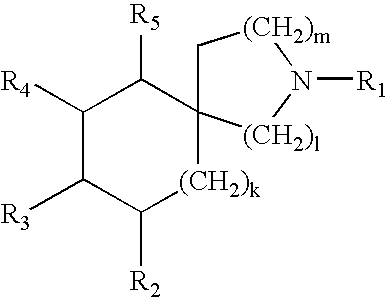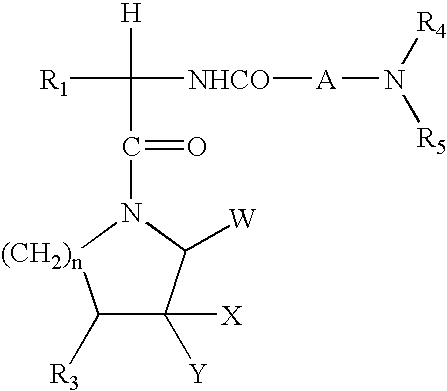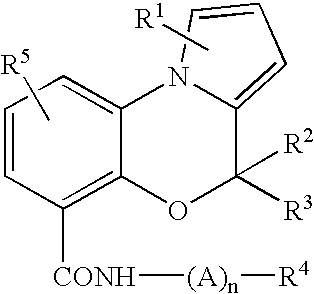Bicyclic and tricyclic amines as modulators of chemokine receptor activity
a chemokine receptor and activity-modulating technology, applied in the field of modulators of chemokine receptor activity, can solve the problems of not being disclosed nor suggested in the prior ar
- Summary
- Abstract
- Description
- Claims
- Application Information
AI Technical Summary
Benefits of technology
Problems solved by technology
Method used
Image
Examples
example 1
Preparation of N-3-[cis-2,3,3a,4,9,9a-hexahydro-1H-benz[f]isoindol-2-yl]-n-prop-1-yl-N′-3-acetylphenylurea
Part A. Preparation of cis-N-Benzyl-1,2,3,4-tetrahydro-2,3-naphthalenedicarboximide
[0594] To a stirred mixture of N-benzylmaleimide (10 g, 53.41 mmol) and zinc dust (2 g, 30.59 mmol) in 250 mL DMF was added in a 6 hour period a mixture of α,α′-dibromo-o-xylene (23 g, 87.13 mmol) and n-benzylmaleimide (5 g, 26.71 mmol) in 50 mL DMF, as well as six portions of zinc dust (1 g, 15.30 mmol). The mixture was stirred at room temperature for 20 hours, over which time a homogeneous solution was observed. The mixture was poured into 1 L water, and 10 mL of concentrated hydrochloric acid was added. The solids were removed by filtration, and the filtrate was extracted with three 500 mL portions of ethyl acetate. The combined extracts were dried over sodium sulfate, and concentrated to an amber oil which was subjected to flash chromatography, eluting with 50% ethyl acetate / hexanes, followe...
example 2
Preparation of N-3-[trans-2,3,3a,4,9,9a-hexahydro-1H-benz[f]isoindol-2-yl]-n-prop-1-yl-N′-3-acetylphenylurea
Part A: Preparation of N-(3-phenylallyl)-allylamine
[0600] A solution of cinnamyl bromide (10 g, 50.7 mmol) in 250 mL tetrahydrofuran was added dropwise to a solution of allyl amine (38 ml, 507 mmol) in 50 mL tetrahydrofuran at 0° C. the mixture was allowed to slowly come to room temperature then stirred 20 hours. The tetrahydrofuran was removed in-vacuo, and the residue was partitioned between 500 mL of ethyl acetate and 200 ml of water. The layers were separated, the organic phase was washed with water followed by brine, then dried over sodium sulfate and concentrated to an amber oil. The oil was purified by flash chromatography on an 8×15 cm silica column, eluting with 5% methanol / chloroform followed by 10% methanol / chloroform. Obtained 7.2 g of an amber oil as product. Yield=81%. NMR (300 MHz, CDCl3) δ 7.39-7.20 (m, 5H), 6.54 (d, 1H, J=16 Hz), 6.35-6.26 (m, 1H), 6.01-5.87...
example 3
Preparation of (+ / −)-N-3-[trans-6-fluoro-2,3,3a,4,9,9a-hexahydro-1H-benz[f]isoindol-2-yl]-n-prop-1-yl-N′-3-acetylphenylurea
Step A. Preparation of 3-(4-fluorophenyl)-3-hydroxy-1-propene
[0607] A solution of 4-fluorobenzaldehyde (8.5 g, 68.2 mmol, Aldrich) in 50 mL of tetrahydrofuran was added dropwise to a solution of vinylmagnesium bromide (9.84 g, 75 mmol, Aldrich) in 150 mL of tetrahydrofuran at 0° C. The mixture was stirred for min and then allowed to warm to room temperature. The reaction was stirred overnight and quenched by the addition of water (100 mL). The resulting precipitate was removed by filtration. The filtrate was concentrated in vacuo and then dissolved in 200 mL of ethyl acetate. This solution was washed with water, brine, dried over sodium sulfate, and concentrated in vacuo to 10.3 g of an amber oil as product. NMR (300 MHz, CDCl3) δ 7.37-7.29 (m, 2H), 7.04 (dd, 2H, J=9 Hz, 9 Hz), 6.08-5.97 (m, 1H), 5.35 (d, 1H, J=17 Hz), 5.21 (d, 2H, J=10 Hz), 1.90 (d, 1H, J=4 H...
PUM
| Property | Measurement | Unit |
|---|---|---|
| molecular weight | aaaaa | aaaaa |
| temperature | aaaaa | aaaaa |
| temperature | aaaaa | aaaaa |
Abstract
Description
Claims
Application Information
 Login to View More
Login to View More - R&D
- Intellectual Property
- Life Sciences
- Materials
- Tech Scout
- Unparalleled Data Quality
- Higher Quality Content
- 60% Fewer Hallucinations
Browse by: Latest US Patents, China's latest patents, Technical Efficacy Thesaurus, Application Domain, Technology Topic, Popular Technical Reports.
© 2025 PatSnap. All rights reserved.Legal|Privacy policy|Modern Slavery Act Transparency Statement|Sitemap|About US| Contact US: help@patsnap.com



